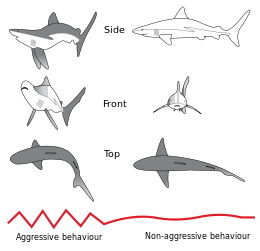Shark threat display

Shark threat display, a type of agonistic display, is a behaviour observed in some sharks when they feel threatened or protective. It consists of a contorting of the body into a series of "ritualized" postures coupled with an exaggerated swimming style. It is most frequently observed in the grey reef shark (Carcharhinus amblyrhynchos), although it has been seen in other sharks.
When threatened, the grey reef shark lifts its snout, holds its pectoral fins stiffly downwards, arches its back and holds its tail sideways. It often accompanies this posture by an exaggerated swimming pattern in a yawing figure-of-eight. The speed and intensity of the display increases as the perceived threat increases (for instance when the possible escape routes for the shark are restricted) and may be interspersed with quick slashing attacks followed by a rapid retreat. The behaviour is highly ritualized and predictable, and is believed to serve some role in normal social interaction. Sharks displaying this behaviour are normally on the verge of either attacking or fleeing, and it indicates a possible non-predatory basis for attacks on humans.[1]
Similar, but less exaggerated, displays have been observed in 23 other shark species, among them the Galapagos shark (Carcharhinus galapagensis), the silky shark (Carcharhinus falciformis), the blacktip shark (Carcharhinus limbatus), the blacknose shark (Carcharhinus acronotus), the great white shark (Carcharodon carcharias), the tiger shark (Galeocerdo cuvier), the bull shark (Carcharhinus leucas) and others.[2][3] It is believed that the breaching and slapping of the tail on the surface of the water exhibited by great white sharks may be an agonistic display, but in this case based on competition for food rather than a perceived danger.[4][5]
References
- ↑ Richard H. Johnson & Donald R. Nelson (1973-03-05). "Agonistic Display in the Gray Reef Shark, Carcharhinus menisorrah, and Its Relationship to Attacks on Man". Copeia. American Society of Ichthyologists and Herpetologists. 1973 (1): 76–84. doi:10.2307/1442360. JSTOR 1442360.
- ↑ Martin, R. Aidan (March 2007). "A review of shark agonistic displays: comparison of display features and implications for shark-human interactions" (PDF). Taylor & Francis. doi:10.1080/10236240601154872.
- ↑ Erich K. Ritter and Alexander J. Godknecht (2000-02-01). Ross, S. T., ed. "Agonistic Displays in the Blacktip Shark (Carcharhinus limbatus)". Copeia. American Society of Ichthyologists and Herpetologists. 2000 (1): 282–284. doi:10.1643/0045-8511(2000)2000[0282:ADITBS]2.0.CO;2.
- ↑ Klimley A.P., Pyle P. & Anderson S.D. (1996). "Tail slap and breach: agonistic displays among white sharks?". Great white sharks: the biology of Carcharodon carcharias. San Diego, California: Academic Press. pp. 241–255.
- ↑ A. Peter Klimley, Burney J. Le Boeuf, Kelly M. Cantara, John E. Richert, Scott F. Davis, Sean Van Sommeran andJohn T. Kelly (2001). "The hunting strategy of white sharks (Carcharodon carcharias) near a seal colony" (PDF). Marine Biology. 138 (3): 617–636. doi:10.1007/s002270000489.